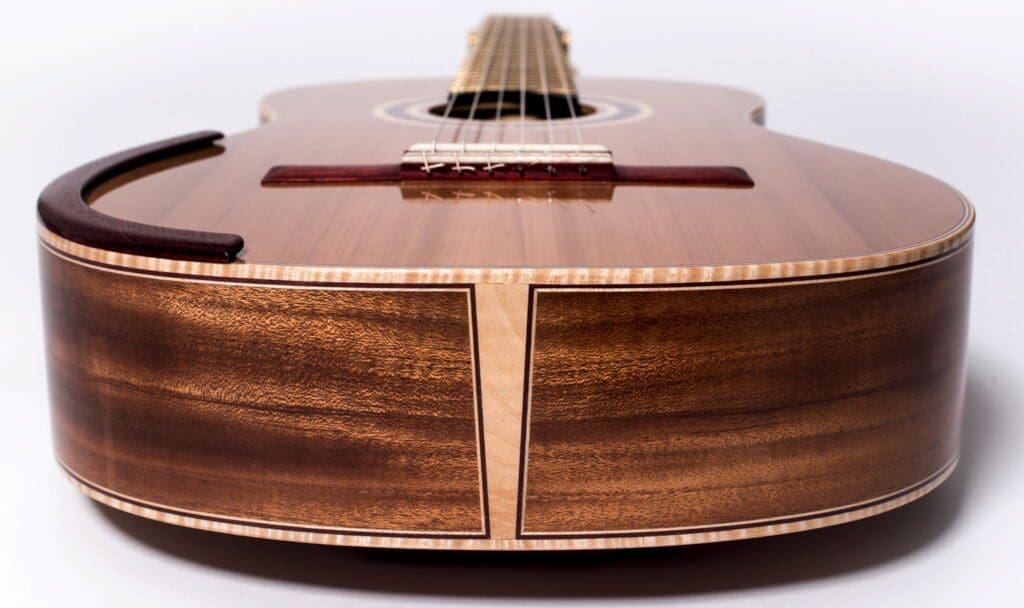Last update 5/2/2024
If you have decided that the classical guitar is the right type for you, we will concentrate on this type of guitar. Our information will also hold you in good stead if you decide to buy a different acoustic guitar later.
Classical Guitar – A Brief History
The classical guitar has its roots in the lute, a popular instrument in Europe during the Middle Ages and Renaissance. In the 16th century, Spanish luthiers began to develop a new type of guitar with a wider body and a longer neck. This new instrument, known as the vihuela de mano, quickly became popular in Spain and throughout Europe.
In the 18th century, the vihuela de mano evolved into the modern classical guitar. This transformation was largely due to the work of Spanish luthier Antonio Torres Jurado, who is credited with developing the distinctive shape and sound of the classical guitar.
Table of contents
- Classical Guitar – A Brief History
- Classical Guitar Basics – Which classical guitar is for you?
- Classical Guitar Basics| Important Considerations
- Top Classical Guitars Brands
- Classical Guitar Basics | Maintenance
- Guitar setups
- Make a list
- Going Shopping: Store vs. Online
- Guitar Accessories
- Guitar service and support
- Tips for Success
- Conclusion
- References
Classical Guitar Basics – Which classical guitar is for you?
Classical guitars or Spanish guitars are used for classical music. The acoustic guitar type features a wooden construction with nylon (gut string) strings.
The Classical guitar, when played, is held and strummed or plucked using the following traditional techniques.
Common playing styles for Classical guitar
Classical guitarists play many musical styles, such as folk, flamenco, and classical. Classical arrangements are made up of complete fingerstyle as well as picking.
Playing seated
The guitarist is in a seated position with one leg raised. The position allows the instrument to rest on the remaining raised leg.
Folk and flamenco often use a particular style of fingerstyle picking. Folk guitar, which begins in bluegrass, differs from the classical style as it uses a thumb pick.
In contrast, the Spanish-rooted flamenco style often differs from the classical style in finger choice when plucking the strings and how the player holds the guitar.
What is different between a Flamenco and a classical guitar?


Often confused, Classical guitars can be used for playing Latin styles of music. Flamenco guitars have a distinct sound: a “percussive pluck.”
Its distinct sound comprises a cypress body (back and sides) with a spruce soundboard. Flamenco guitars also have a thinner design, giving the sound percussive quality.
Every guitar type has its distinctive differences; however, many guitar components share the same function as other guitar types. We will now explain the technical elements of a classical guitar.
Classical guitar tonewoods
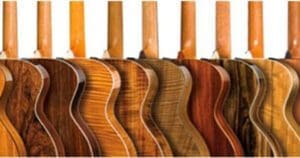

For the most part, guitars use wood for the body, neck, and top.
While esthetics are necessary, we want the guitar to look nice. However, a guitar’s choice of woods influences the instrument’s tone. Therefore, you must make the right choice.
Various types of woods are known for their specific tonal quality. Think of wood like ingredients in a cake. Timbers are chosen for their tonal and visual quality and are used in the guitar’s construction accordingly.
Spruce
It is a prevalent choice by guitar manufacturers.
The woods are very popular because of their versatility. Sitka spruce is the most popular Spruce wood used in classical guitars.
Spruce offers crisp and powerful sound. It has a wide dynamic range, which covers many human hearing frequencies. Furthermore, it provides clarity along with simplicity for the overall tone.
Soundboards are usually a type of Spruce that influences much of the guitar’s overall tone.
Cedar
Cedar is most commonly an option for the soundboard. Cedar’s tone is less clear and less distinct than Spruce’s.
Cedar adds complexity and a level of warmth, which some players like. This wood is also quieter when the guitar is strummed quite hard. In summary, cedar overall is a warmer tone, which some guitarists prefer.
Maple
Guitars often use maple for the back, sides, and soundboard. Maple is a dense wood, creating crisp, clear tones, especially in the higher frequencies.
A guitarist who plans to amplify their classical guitar often uses Maple as a Tonewood. Furthermore, it’s an excellent choice for recording also.
The overall sound of guitars that feature Maple is crisp and clear in high-end tones. It’s a bright, clear sound that cuts through the mix when the guitar is in a live or recording setting.
Mahogany
Mahogany is another tonewood used for the neck and sides of the guitar.
It has stood the Test of time—guitars using Mahogany sound rich and full.
Rosewood
Rosewood offers excellent sound projection with a decent volume level in the bass. The sound is consistent and versatile, often used in beginner or affordable classical guitars. It offers a well-rounded tone that lends itself to lots of styles.
Guitars with Rosewood guitar backs, sides, and spruce tops are prevalent. The overall combination of Rosewood and a Spruce top is common for many Classical guitars.
Classical Guitar Basics – Construction


How a guitar is built is key to how it sounds and may impact your decision.
Understanding the components of a classical guitar will help you decide which One is the right one for you.
Okay, we shall keep the technical jargon to a minimum. We will, however, reference the technical variations so that you will understand the differences between them.
Soundboard
We’ve already briefly mentioned the soundboard; starting with the guitar’s anatomy seems appropriate. Okay, we want to make a significant point: the soundboard is crucial for how a classical guitar will sound.
The type of construction and tonewood used for the soundboard will significantly impact the guitar’s tone.
How the soundboard works in simple terms
The soundboard gets its name from how it works. When the guitar stings are plukked or stummed, the strings vibrate.
The vibrating strings cause the soundboard to vibrate, which causes the soundboard to resonate and create the guitar’s sound—furthermore, it’s essential to know that the guitar’s body shape also affects the guitar’s resonance.
Simply put, the vibrating strings cause the soundboard to vibrate, too. Together with the guitar’s body, the soundboard amplifies the sound of the strings.
Soundboards construction
Soundboards – are most often constructed from laminated wood. (usually three) or layers of wood or solid-body wood.
Solid wood is the preferred type of soundboard. However, most often, more affordable guitars utilize laminated wood.
If your budget is tight, consider a guitar with a laminated soundboard. The reality is that lots of budget guitars have laminated soundboards.
With that, it is said many guitars with laminated tops sound great. However, a solid top is the preferred option for many guitarists.
Soundboards woods
Cedar, Spruce, and Mahogany are common choices, and their tonal qualities are described above. Tonal woods are known for their various sound quality.
Fretboard | fingerboard
The names fretboard and fingerboard mean the same thing. The fretboard has many grooves cut into the fingerboard to house the frets.


The fingerboard is the longboard on the guitar’s neck. It is also where the guitarist places their hand to make a chord or play a melody.
The fretboard on a classical guitar has the distinction of being wider than most other guitars. The woods used for fingerboards are often Rosewood, Mahogany, and Ebony; however, Rosewood is most common.
While it is generally accepted that the fretboard does not impact the sound of the Classical guitar, it is a critical consideration in terms of comfort and playability. Therefore, the thickness and profile of the guitar neck are often considered the most crucial consideration for the guitarist.
Note: Whether or not the tonal differences between various wood types are an ongoing matter of debate within much of the guitar community. If any discrepancies are apparent, it’s likely to be minuscule.
The fretboard position markers
The fretboard position markers indicate where the hand and fingers are on the fingerboard to the player.
The frets
The frets are metal strips located in grooves cut into the fingerboard. A guitar string/s is depressed behind the fret, and the plucked string/sounds a musical note.
The Headstock
The headstock is attached to the top of the guitar neck. The tuning keys are connected to the headstock.
Body
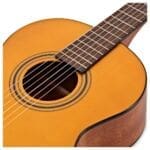

The guitar’s body is the main structure and bulk of the guitar. The size of the guitar’s body significantly impacts its feel and sound.
Thicker bodies tend to have a rich sound in the lower frequencies. Conversely, a thinner body will tend to have its higher frequencies ring out.
The neck
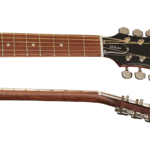

The guitar’s neck’s width is much wider than most other guitar types. The feel of the neck is one of the most critical features for guitarists. When trying various guitars, the feel of the neck, albeit good or bad, will be apparent.
The nut
The guitar nut is where the fretboard meets the headstock. Its purpose is to keep the strings appropriately spaced across the fretboard and the string spacing at the correct height from the top of the 1st fret. The nut is often synthetic plastic or some other derivative. More expensive guitar models usually have bone construction; some guitarists believe a bone nut is slightly louder with clearer tones.
The saddle
The saddle locates and spaces the guitar strings correctly where strings meet the saddle. The bridge is attached to the guitar body.
Tuning Pegs
A classical guitar’s headstock (or just head) is pretty straightforward in design terms. Check the tuning pegs and ensure they are easily adjusted and work smoothly. Poor-quality tuners will allow the guitar to lose its proper tune.
Classical guitar strings
Let there be no doubt: Classical guitars sound lovely. The sound is in no small part due to the nylon strings, one of the main features that set its parts from Steel-string acoustics or electric guitars.


The main characteristic of nylon strings is the soft, pleasant sound. Furthermore, when plucked, nylon strings use significant vibrational amplitude.
The reason is to require sufficient space between the strings to ensure they don’t hit the adjacent string.
Strings 1 through 3 The strings are what produce the high-pitched treble tones.
These are single transparent nylon strings. Strings 4 through 6 make the low base tones, which are usually silver in color, but they are made from around 200 individual strands of nylon hat wrapped with silver-plated copper thread.
Also, as we have already said, the guitar’s neck is wider than most other guitar types. It is wider to allow the player’s fingers to press down a string and not contact other strings, especially when the guitarist plays fast musical pieces.
Scale length
A guitar’s scale length refers to the strings’ length from the nut to the saddle. Scalelength significantly affects the guitar’s playability. A long scale length creates more string tension. It makes the string harder to fret and bend.


Conversely, a shorter scale length makes for less string tension. Strings are easier to fret and bend.
String tension is not nearly as noticeable for classical guitars with nylon strings.
Classical guitar tunings
Though many tunings for any guitar, a classical guitar is not tuned differently from a regular acoustic guitar; the standard tuning is still E-A-D-G-B-e. This means that notation designed for acoustic or electric guitar can still be used to learn to play a classical guitar. Classical tabs are not needed.
Guitar | Overall size
Choosing the right size for your classical guitar might seem straightforward. However, it does deserve proper consideration.
An adult of average or above-average size and height may find a full-sized classical guitar is for you. The body of a classical guitar isn’t as large as many other acoustic guitars. Therefore it is likely to be relatively comfortable. However, there is more to consider.
Suppose you are a more petite adult or purchasing a guitar for someone younger or perhaps smaller in stature.
Common classical guitar sizes
Choose the size of the guitar very carefully. The body size and scale length can significantly affect the guitar’s playability and sound.
¼ size. It is designed for children and is suitable for ages up to about five years old, depending on the child’s overall size.
½ size. These are also designed for children and suitable for ages up to approximately 8, depending on the child’s size. These guitars are not ideal for most adults.
This size suits older children up to 12 years old and very petite adult players.
You may opt for a ¾ sized guitar as an adult because the fretting hand (usually the left) may feel awkward around a full-sized fretboard.
Deciding on a proper guitar size, having never held one. If you visit a guitar store with an extensive selection of classical guitars, you should try ¾ size, ⅞ size, and full-sized guitars. Decide which feels more natural for your body type.
Classical Guitar Basics| Important Considerations
Let’s consider some critical factors influencing your classical guitar buying decisions.
Top Classical Guitars | Pros and cons
You need to make a note of the following information.
Pros
Especially for beginners, nylon strings are generally easier to play than steel strings on acoustic guitars. Nylon strings need less finger strength when fretting and are less likely to leave you with calloused fingers, the curse of lots of new guitar players.
Classical guitar has its unique tone, which is precisely what you want. The classical guitar is often used for Brazilian and Spanish guitar playing.
Cons
The neck and fretboard tend to be much wider than other types of guitar. If you are familiar with playing an acoustic or electric guitar, some adjustment may be required until you become used to the wider neck.
Furthermore, becoming acquainted with the classical guitar’s wider neck may take some time.
Classical guitars, like any other guitar type, have positives and negatives.
Classical Guitar Basics – Prices
The price between cheap and expensive classical guitars is significant. Take your time checking prices. Affordable classical guitars begin around $100-200. High-end professional model classical guitars can run into many thousands.
Factors that impact the price of classical guitars
The tonewoods used in construction significantly influence the guitar’s price. For example, a fretboard made from Brazilian Rosewood is more costly than Indian Rosewood.
Mahogany is a strong wood, an example of a desirable wood for classical guitars but also expensive.
Hardware
The hardware of guitars typically includes tuning pegs and nuts. These are often made from plastic or other materials such as bone or metal. As a rule, the better the material, the higher the price.
Brands with a reputation for making high-quality guitars may cost slightly more than a lesser-known brand.
A manufacturer’s signature or limited edition model often impacts the price. Guitar makers love to do this; they obtain an endorsement from a celebrity player or make a previously discontinued model.
Nothing is wrong with this; however, you may pay a premium for words like ‘limited edition’ and ‘signature. There may not be any other differences compared to the standard line of the same instrument.
Ultimately, only you can determine if the additional cost is worth it.
Your Budget


What might you expect when buying a model within a specific price bracket? What is the minimum spend for a beginner’s classical guitar?
We always say buy the best guitar you can afford. Good quality guitars that are looked after will hold their value.
Under $100
Classical guitars priced around $100 or less are affordable or entry-level. Build quality and components are used to reduce the overall cost of the guitar as much as possible.
Suitable for children or anyone whose budget will not extend to a higher quality guitar. Also, one caveat is if you are looking for a half-sized guitar or even ¾ size.
$100-250
You can find excellent guitars at this first price point and above. Many big brands have something to offer at a price under $250. Also, many guitars sold at this price are specifically aimed at beginners.
A guitar bundle will generally consist of items such as picks, a case, a tuner, and spare strings. Buying may save money.
$250-500
You can expect more intermediate classical guitars at this price point. You can expect slightly better quality woods and hardware, such as bone and metal tuning pegs, at this price.
$500-1000
Expect an upper to high intermediate quality for this price point.
$1000 plus
You should expect good quality if you plan to spend over $1000 on a guitar. Expect: Top tonewoods, excellent craftsmanship, and a beautiful feel and look should all be expected if you spend this kind of money.
Top Classical Guitars Brands
Brands like “Dupont” and other obscure manufacturers are prevalent on the higher end of the guitar market. Many different small boutique brands are also available.
Many manufacturers make these products by hand on a small scale and may only produce a limited number of guitars.
Yamaha
Yamaha is well known for making quality musical instruments. There is no exception for their classical guitars. Yamaha makes some excellent classical guitars at almost any of the price points we’ve discussed as acceptable. Buying a Yamaha guitar will almost guarantee quality.
Cordoba
Possibly one of, if not the best, a brand that mass-produces classical guitars is. Cordoba is a manufacturer with a massive history. They’ve been producing instruments since 2007. The quality on offer and the value within their range mean Cordoba classical guitars are among the most popular of all. Their guitars range from around $150 up to $1000.
There is a growing list of pro musicians that use Cordoba guitars. However, they also manufacture Ukuleles and other instruments such as acoustic bass guitars; classical is undoubtedly unique.
Takamine
Takamine manufactures many different guitars, mainly acoustic, with a small section of their brand devoted to classical guitars. However, it isn’t their specialism; some acceptable models are within their range.
Fender (and Squier)
Similarly, we associate Fender primarily with its range of iconic electric guitars. Fender manufactures acoustic guitars also.
Their range includes a few classical guitars, some of which are excellent quality. Furthermore, the Squier options include a “Classical Acoustic Guitar bundle,” which is ideal for beginners and available at a very reasonable price.
Dean
Dean offers a vast range of guitars. They manufacture electric, acoustic, and classical bass guitars. Their classical guitars vary in materials and price, so there is plenty of selection for those who intend to purchase from this range.
Stagg
Stagg offers a great range of guitars in all shapes and sizes. They build different types of classical guitars for the budget market.
Classical Guitar Basics | Maintenance
You will want to keep your guitar looking and playing like new.


All acoustic guitars can be affected by humidity. Ideally, keep your acoustic guitar in a humidity range of approximately 44% to 55%
How to maintain and protect your guitar
Invest in a good quality guitar case, especially if you take your guitar out and about a lot. The guitar case will help protect your guitar from humidity and extreme temperature changes and stop it from warping. Avoid temperature changes and extremes altogether. Avoid sudden temperature changes when possible. Do not take a guitar from freezing outside to warm inside. Climatize the guitar slowly to its current conditions.
Use a humidifier
The ideal humidity for wood is about 40-55%. Monitor the humidity using a hygrometer in the case or in the room where you usually keep your guitar.
Clean the fingerboard regularly with a soft, dry cloth. Furthermore, use an oil fit for the fingerboard from time to time. Also, oil provides a level of protection by stopping the fingerboard wood from soaking up any water or sweat. Lubricate the string slots within the nut to stop them from creaking, making it difficult to move when tuning the guitar. You can use the lead from a pencil. However, we recommend using a product specially made for the purpose, such as nut lube.
How often should I change guitar strings?
There is no simple, definitive answer to this question. Guitarists often debate the answer. In short, replace the guitar strings when there is a loss of tone or if any corrosion has reached an unacceptable level. However, you will develop your preferences in time.
Replace strings regularly. This won’t impact your guitar for long, but old strings can go out of tune more quickly and not sound as good as they should.
Guitar setups
A guitar’s action will be adjusted if needed as part of a guitar’s setup.
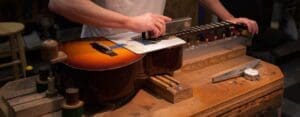

The guitar’s action
A guitar’s action refers to the space between the strings and the frets. If the gap is too much, it is called a high action. If the gap is too small, that is called a low action.
High action makes pushing the fingers down onto the fret harder. High action can make the guitar harder to play. Playing bends and slides can also be more difficult.
Low actions typically make the guitar easier to play. However, if the guitar’s action is too low, it makes for problems such as buzzing coming from the strings because they are touching the frets as they vibrate.
How can I stop strings from buzzing?
String buzz can be due to lousy technique by an inexperienced player or a guitar setup problem. Buzzing is a prevalent issue among beginner guitarists. It often happens because they haven’t quite nailed their technique yet. If you are sure that the guitar itself is causing the buzzing, it could be that the guitar’s action is incorrect.


It may be well worth taking it to a reputable music store to get the action checked and adjusted if required. Ideally, the action should be low to the fretboard but not so low that it buzzes.
Your guitar is an investment, and it is well worth taking good care of it. Suppose there is an issue with the guitar. Seek out an experienced luthier to have any other issues corrected. A reputable music store will often have staff capable of helping with things like replacing the strings and tweaking the guitar’s action if needed.
Guitar maintenance is an excellent skill to have, but you don’t have to go it all alone.
What is a crossover guitar?
Crossover guitars are similar to standard acoustic guitars, however, most often with a cutaway section and nylon strings, just like a traditional classical guitar. The tone is very similar to a classical guitar. However, the crossover is easier to access the higher guitar register. Furthermore, they have thinner necks designed to be like an acoustic guitar to play if you are accustomed to the dynamics of an acoustic guitar. An electro-acoustic guitar is designed to have a pickup built-in and send the sound via a signal amplified to an amp or PA system. Electro-acoustic guitars come in all different types, including classical guitars. Electro-acoustic guitars allow you to plug in and play to crowds or in a large venue. Some electro-acoustic guitars also have inbuilt tuners, which can be a bonus.
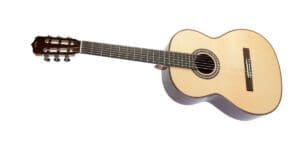

Add a pickup | Plug it in
Another method of amplifying your classical guitar is to add a pickup to the guitar’s Soundhole.
Many guitarists also like the traditional microphone method in front of the Soundhole. If you are a solo musician, this is certainly a simple option, and if you sit down to play, it is far more accessible. Doing so preserves your guitar’s natural tone and can avoid the harsh sounds that an electro-acoustic sometimes makes.
Make a list
Make a list of everything you need to know before you go shopping. There is a lot to remember when shopping for a guitar. An example:
Your budget | maximum spend including a case and accessories.
Preferred tonewood combination
Going Shopping: Store vs. Online
Your best option to buy is from a reputable guitar shop. Trying the guitar before buying is essential.
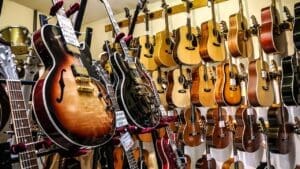

However, we know that going to a guitar store isn’t always an option for many reasons. While buying online is not our preferred recommendation, buying online from a reputable dealer is our following recommendation.
There are many online shopping options. A great many of them are reputable and honest. Ensure you are fully aware of all the company’s selling, shipping, and return policies. Waiting until something goes wrong is not a good idea.
Tips for Test Driving Classical Guitars
Play some quality instruments when you have an opportunity to do so.
Our Guitar Buying tips
Guitar Accessories
The hardware of guitars typically includes tuning pegs and nuts. These are often made from plastic or other materials such as bone or metal. As a rule, the better the material, the higher the price.
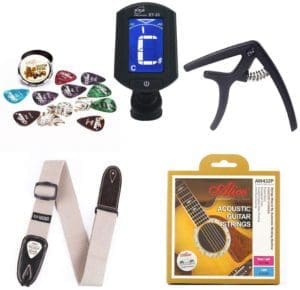

- Spare strings
- Guitar maintenance kit. Polishing cloths and polish for your guitar type of finish.
- String winder (optional)
- Guitar stand
- Guitar case or gig bag (if your guitar does not come with a case)
- Humidity pack ( if you are in an area of minimal humidity ( less than 45%)
- Guitar tuner (or use a smartphone app)
- A guitar strap
Guitar service and support
Before purchasing any guitar, ask about support should your guitar need to be returned.
Guitar return policy, if any.
Procedures should any warranty issues arise.
Tips for Success
Here are a few tips for success as you learn to play the classical guitar:
Practice regularly: The best way to improve your guitar playing is to practice regularly. Try to set aside at least 30 minutes each day to practice.
Be patient: Learning to play the classical guitar takes time and effort. Keep going even if you don’t see results immediately. Just keep practicing, and you’ll eventually reach your goals.
Find a community: There are many online and offline communities for classical guitarists. Connecting with other guitarists can be a great way to stay motivated and learn from others.
Conclusion
A classical guitar is a thing to behold, both visually and aurally.
Try to play as many guitars as you can. Take notes for each guitar you try; most of us become confused when shopping for a guitar.
Speak to as many Classical guitar players as you can, if possible. Read lots of reviews from reputable sources. Take your time and enjoy your journey searching for and buying your dream Classical guitar. Popular Classical guitars
If you have any questions or need help getting started, please don’t hesitate to contact me. guitaradvice.comatgmail.com
References
Classical guitar. (2021, December 28). Retrieved from https://en.wikipedia.org/wiki/Classical_guitar

